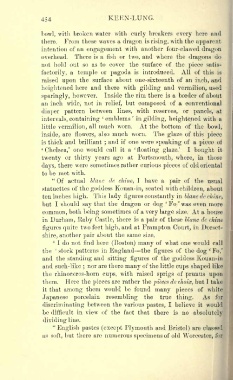Page 490 - Chinese Porcelain Vol II, Galland
P. 490
KEEN-LUNG.
454
bowl, with broken water with curly breakers every here and
there. From these waves a dragon is rising, with the apparent
intention of an engagement with another four-clawed dragon
overhead. There is a fish or two, and where the dragons do
not hold out so as to cover the surface of the piece satis-
a or is introduced. All of this is
factorily, temple pagoda
raised upon the surface about one-sixteenth of an inch, and
here and there with and vermilion, used
heightened gilding
however. Inside the rim there is a border of about
sparingly,
an inch wide, not in relief, but composed of a conventional
between lines, with or at
diaper pattern reserves, panels,
' emblems '
intervals, containing in gilding, heightened with a
little vermilion, all much worn. At the bottom of the bowl,
inside, are flowers, also much worn. The glaze of this piece
is thick and brilliant ; and if one were speaking of a piece of
* it a '
Chelsea,' one would call floating glaze.' I bought it
twenty or thirty years ago at Portsmouth, where, in those
there were sometimes rather curious of old oriental
days, pieces
to be met with.
"
Of actual Nanc de chine, I have a pair of the usual
statuettes of the goddess Kouan-in, seated with children, about
ten inches high. This lady figures constantly in blanc de chine,
'
but I should say that the dragon or dog ' Fo was even more
common, both being sometimes of a very large size. At a house
in Durham, Raby Castle, there is a pair of these Uanc de chine
figures quite two feet high, and at Frampton Court, in Dorset-
shire, another pair about the same size.
"
I do not find here (Boston) many of what one would call
the ' stock patterns in England the figures of the dog ' Fo,'
and the standing and sitting figures of the goddess Kouan-in
and such-like ; nor are there many of the little cups shaped like
the rhinoceros-horn cups, with raised sprigs of prunus upon
them. Here the pieces are rather the pieces de choix, but I take
it that among them would be found many pieces of white
Japanese porcelain resembling the true thing. As for
discriminating between the various pastes, I believe it would
be difficult in view of the fact that there is no absolutely
dividing line.
"
English pastes (except Plymouth and Bristol) are classed
as soft, but there are numerous of old Worcester, for
specimens

